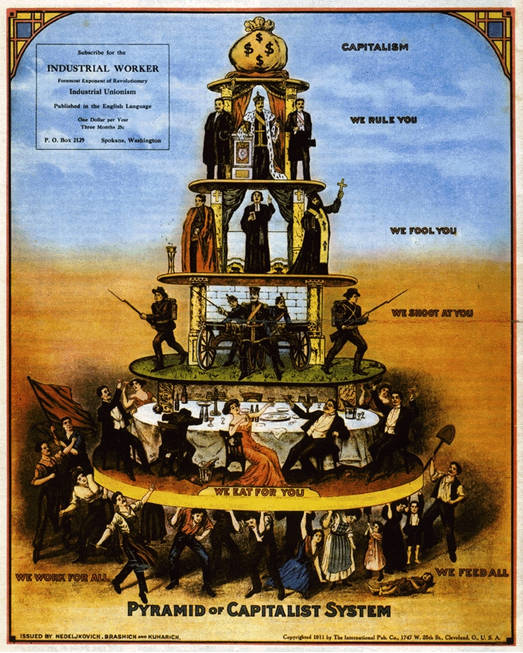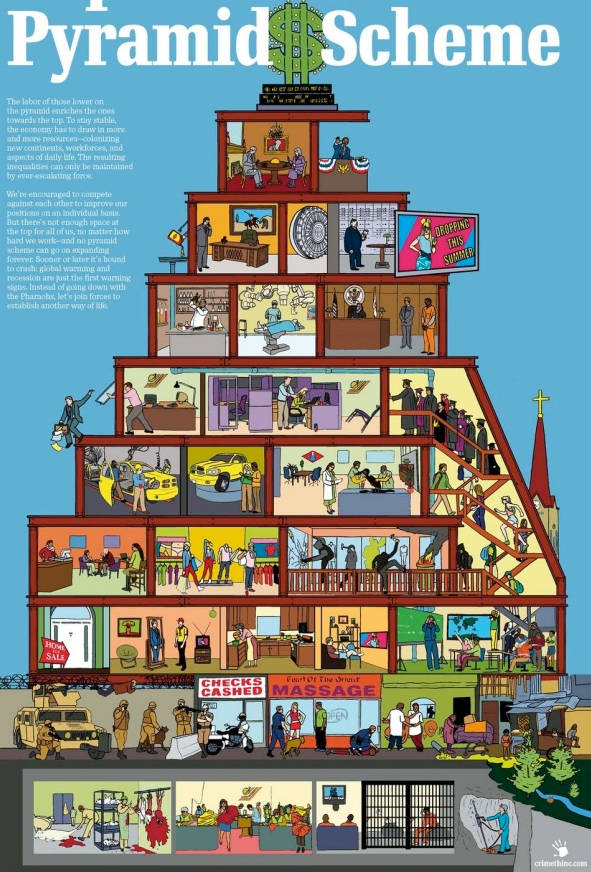Does REAL Capitalism Exist?
Capitalism is an economic system in which trade, industry, and the means of production are largely or entirely privately owned and operated for profit. Central characteristics of capitalism include private property, capital accumulation, wage labour and, in some situations, fully competitive markets. In a capitalist economy, the parties to a transaction typically determine the prices at which they exchange assets, goods, and services
The degree of competition, the role of intervention and regulation, and the scope of state ownership vary across different models of capitalism. Economists, political economists, and historians have adopted different perspectives in their analyses of capitalism and have recognized various forms of it in practice. These include laissez-faire or free market capitalism, welfare capitalism, crony capitalism, corporatism, "third way" social democracy and state capitalism. Each model has employed varying degrees of dependency on free markets, public ownership, obstacles to free competition, and inclusion of state-sanctioned social policies.
Capitalism - Wikipedia website
The degree of competition, the role of intervention and regulation, and the scope of state ownership vary across different models of capitalism. Economists, political economists, and historians have adopted different perspectives in their analyses of capitalism and have recognized various forms of it in practice. These include laissez-faire or free market capitalism, welfare capitalism, crony capitalism, corporatism, "third way" social democracy and state capitalism. Each model has employed varying degrees of dependency on free markets, public ownership, obstacles to free competition, and inclusion of state-sanctioned social policies.
Capitalism - Wikipedia website
Mixed economy
Example: The American School (also known as the National System) is the economic philosophy that dominated United States national policies from the time of the American Civil War until the mid-twentieth century. It consisted of three core policy initiatives: protecting industry through high tariffs (1861–1932) (changing to subsidies and reciprocity from 1932–1970s), government investment in infrastructure through internal improvements, and a national bank to promote the growth of productive enterprises. During this period the United States grew into the largest economy in the world, surpassing the UK (though not the British Empire) by 1880.
Mixed Economy - Wikipedia website
American School
The American School, also known as the "National System", represents three different yet related constructs in politics, policy and philosophy. It was the American policy from the 1860s to the 1970s.
American School Economy - Wikipedia website
Example: The American School (also known as the National System) is the economic philosophy that dominated United States national policies from the time of the American Civil War until the mid-twentieth century. It consisted of three core policy initiatives: protecting industry through high tariffs (1861–1932) (changing to subsidies and reciprocity from 1932–1970s), government investment in infrastructure through internal improvements, and a national bank to promote the growth of productive enterprises. During this period the United States grew into the largest economy in the world, surpassing the UK (though not the British Empire) by 1880.
Mixed Economy - Wikipedia website
American School
The American School, also known as the "National System", represents three different yet related constructs in politics, policy and philosophy. It was the American policy from the 1860s to the 1970s.
American School Economy - Wikipedia website
Modern Capitalism: was carried across the world by broader processes of globalization such as imperialism (Militarism) and, by the end of the nineteenth century, became the dominant global economic system, in turn intensifying processes of economic and other globalization. Later, in the 20th century, capitalism overcame a challenge by centrally-planned economies and is now the encompassing system worldwide, with the mixed economy being its dominant form in the industrialized Western world.
Official types: Mercantile Capitalism, Industrial Capitalism, Financial Capitalism, State-Welfare Capitalism
What is happening today: Crony Capitalism, Oligarchic capitalism, Corporate Capitalism, Conflict Capitalism, Disaster Capitalism
Official types: Mercantile Capitalism, Industrial Capitalism, Financial Capitalism, State-Welfare Capitalism
What is happening today: Crony Capitalism, Oligarchic capitalism, Corporate Capitalism, Conflict Capitalism, Disaster Capitalism
Market Economics vs Command Economies
- Market Economics
- Mercantilism: the law gives preference and special benefits to the sector of the economy owned by the government.
- Corporatism: the law gives preference and special benefits to the sector of the economy owned by big corporations within the nation (sometimes referred to simply as "Big Business").
- Capitalism: the law gives preference and special benefits to the sector of the economy owned by big capital (including big corporations like in Corporatism, but also wealthy foreign and multinational corporations and non-corporate institutions, wealthy foundations, wealthy trusts, non-profit entities, wealthy families, monied foreign investors, and others with mass amounts of capital).
- Entrepreneurial capitalism: is the kind that produces new breakthroughs like the automobile, the telephone and the computer. These innovations are, according to the authors, usually the product of individuals and new firms.
- Big-firm capitalism: is a variety that takes advantage of economies of scale and network effects. This type is important for mass production of products.
- Oligarchic capitalism: differs from the state-led variety largely in the motivations of its leaders. The oligarchic variety is oriented towards protecting and enriching a very narrow fraction of the population.
- European capitalism:
- The "Nordic model" (Denmark, Finland, Sweden, plus the Netherlands) has the highest public spending on social protection and universal welfare provision. Labour markets are relatively unregulated but there are "active" labour market policies, while strong unions deliver a high degree of wage equality.
- The "Anglo-Saxon" model (Ireland and the UK) provides quite generous social assistance of last resort, with cash transfers going mainly to people of working age. Unions are weak and the labour market relatively unregulated.
- The "Rhineland model" (Austria, Belgium, France, Germany and Luxembourg) relies on social insurance for those out of work, as well as for provision of pensions. Employment protection is stronger than in the Nordic countries. Unions are also powerful or enjoy legal support for extension of the results of collective bargaining.
- Finally, the "Mediterranean" model (Greece, Italy, Portugal and Spain) concentrates public spending on old-age pensions. Heavy regulation protects (and lowers) employment, while generous support for early retirement seeks to reduce the number of job-seekers.
- Keynesianism: the law gives preference and special benefits to companies and institutions (corporate but especially non-corporate) that are so big that they care more about their public image for societal responsibility and promoting social justice than about profit(s), market share or stock value.
- Free Enterprise: the law gives no special preference; it protects equal rights for all individuals and entities and leaves initiative and enterprise to private individuals, groups, businesses and organizations that are all treated equally and with minimal legislation by the legal code.
- Oligarchic capitalism: which is prevalent in much of Latin America, Africa, and the Middle East, is to be avoided because it's designed to promote the interests of the ruling few.
- Command Economies:
- Socialism
- Collectivism = most freedom
- Fascism
- Communism
- Authoritarianism
- Totalitarianism
Note: all of these subtypes are market-based, though according to Keynes himself Keynesianism "seeks the goals of socialism through market means."
Who Has the Best Capitalism
List of the "World's Most Competitive Economies": Country Rankings 2006-2007
Average number of hours worked per year:
Ratio of CEO pay to average manufacturing employee:
Productivity per hour worked (United States=100)
- Switzerland
- Finland
- Sweden
- Denmark
- Singapore
- U.S.
- Japan
- Germany
- Netherlands
- U.K.
- Hong Kong
- Norway
- Taiwan, China
- Iceland
- Israel (Source: Global Competitiveness Report, World Economic Forum)
Average number of hours worked per year:
- US: 1777
- Germany: 1362
- France: 1346
- Sweden: 1316
- Netherlands: 1309 (Source: OECD (2004), OECD in Figures, OECD, Paris)
Ratio of CEO pay to average manufacturing employee:
- US: 475:1
- Britain: 24:1
- France: 15:1
- Sweden: 13:1 (Source: "Europe vs. America," Tony Judt, Feb. 10, 2005, New York Review of Books)
Productivity per hour worked (United States=100)
- Norway: 119.7
- Belgium: 109.0
- Netherlands: 105.2
- France: 104.9
- Germany*: 103.9
- US: 100
- Finland: 89.5
- Sweden: 88.0
- Britain: 85.3
- Canada: 84.0
Examples of Different Governments (some humor)
TRADITIONAL CAPITALISM You have two cows.
You sell one and buy a bull.
Your herd multiplies, and the economy grows.
You sell them and retire on the income.
COMMUNISM
You have two cows.
The state takes both and gives you some milk.
FASCISM
You have two cows.
The state takes both and sells you some milk.
NAZISM
You have two cows.
The state takes both and shoots you.
BUREAUCRATISM
You have two cows.
The state takes both, shoots one, milks the other and then throws the milk away.
AMERICAN VENTURE CAPITALISM
You have two cows.
You sell three of them to your publicly listed company, using letters of credit opened by your brother-in-law at the bank, then execute a debt/equity swap with an associated general offer so that you get all four cows back, with a tax exemption for five cows. The milk rights of the six cows are transferred via an intermediary to a Cayman Island company secretly owned by the majority shareholder who sells the rights to all seven cows back to your listed company.
The annual report says the company owns eight cows, with an option on one more.
You sell one cow to buy a new president of the United States, leaving you with nine cows.
No balance sheet provided with the release.
The public then buys your bull.
A FRENCH CORPORATION
You have two cows.
You go on strike, organize a riot and block the roads, because you want three cows.
A JAPANESE CORPORATION
You have two cows.
You redesign them so they are one-tenth the size of an ordinary cow and produce twenty times the milk.
You then create a clever cow cartoon image called "Cowkimon" and market it worldwide.
A GERMAN CORPORATION
You have two cows.
You reengineer them so they live for 100 years, eat once a month and milk themselves.
AN ITALIAN CORPORATION
You have two cows, but you don't know where they are.
You decide to have lunch.
A SWISS CORPORATION
You have 5,000 cows. None of them belong to you.
You charge the owners for storing them.
A CHINESE CORPORATION
You have two cows.
You have 300 people milking them.
You claim that you have full employment and high bovine productivity.
You arrest the newsman who reported the real situation.
AN INDIAN CORPORATION
You have two cows.
You worship them.
A BRITISH CORPORATION
You have two cows.
Both are mad.
AN IRAQI CORPORATION
Everyone thinks you have lots of cows.
You tell them that you have none.
No one believes you, so they bomb the crap out of you and invade your country.
You still have no cows, but at least now you are part of a democracy.
AN AUSTRALIAN CORPORATION
You have two cows.
Business seems pretty good.
You close the office and go to the pub for a few beers to celebrate.
A NEW ZEALAND CORPORATION
You have two cows.
The one on the left looks very attractive.
A GREEK CORPORATION
You have two cows.
You borrow against the cows from the Germans.
You kill the cows and make souvlaki.
You can't pay the interest, so the Germans lend you more money.
You can't pay the interest, so the French lend you more money.
You can't pay the interest, so the Italians lend you more money.
You can't pay the interest, so the Spaniards lend you more money.
You can't pay the interest, so your people hold a general strike.
You can't pay the interest, so the EU bails you out.
You drink more ouzo.
Old - Capitalism

New - Capitalism is a Pyramid Scheme
